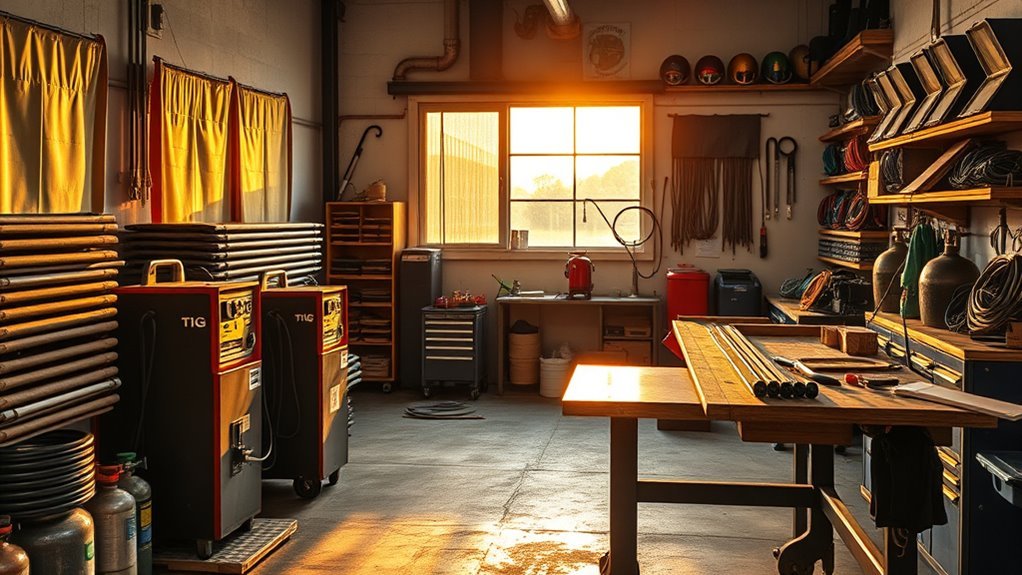Like plotting a blueprint for a bridge, you need precise numbers before you build a welding shop — and those numbers will determine if it stands or collapses. You’ll want to know typical startup ranges, essential machines and PPE costs, facility and utility obligations, licenses and insurance, plus payroll and marketing estimates so you can price work to recover your investment; keep going and you’ll get a clear, line-item picture to plan from.
Initial Startup Costs and Budget Breakdown

When you’re planning a welding shop, start by itemizing every expected cost so you won’t be surprised later: initial startup expenses typically run from about $15,000 to over $50,000 depending on the scale, with basic welders from roughly $1,000 up to high-end systems that can cost substantially more.
You’ll break costs into one-time purchases (licenses, insurance, initial marketing) and recurring obligations (payroll, rent, utilities, materials). Do an overhead analysis to quantify monthly burn and determine the minimum revenue needed to stay solvent.
Separate one-time startup costs from recurring overhead, run an overhead analysis, and calculate the minimum monthly revenue to break even.
Factor in equipment financing terms if you’re not buying outright — compare interest, down payments, and depreciation impact on cash flow. Build a contingency line for unexpected overruns; experience shows initial estimates often fall short.
Create a detailed budget spreadsheet that ties startup capital, financing schedules, and monthly overhead projections to realistic revenue scenarios so you can decide whether to scale back scope or secure additional funding before opening.
Essential Welding Equipment and PPE Expenses
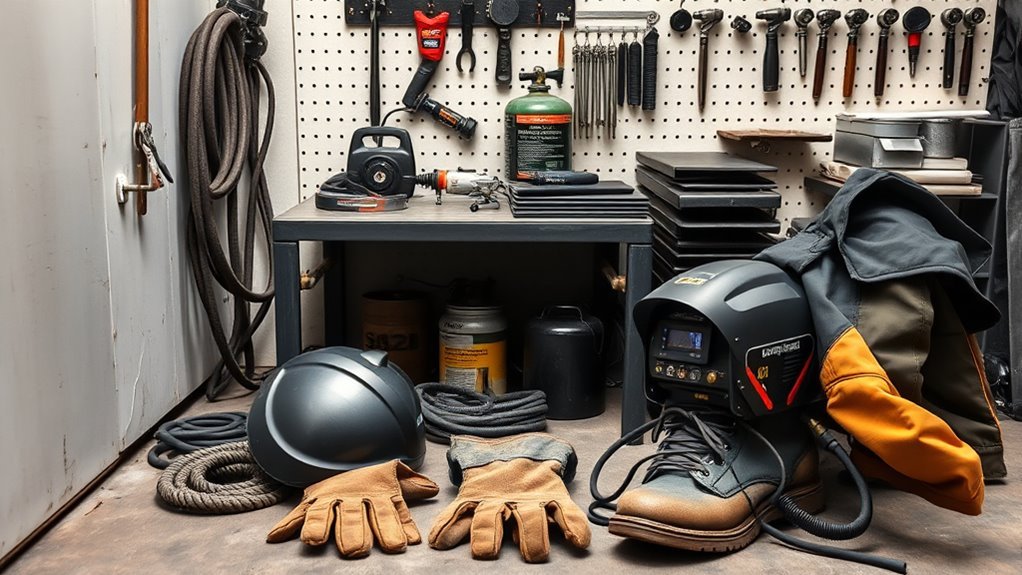
Although the total outlay can vary from roughly $1,000 for a bare-bones setup to well into the millions for a full-scale shop, you’ll want to prioritize a core set of machines and PPE that balance capability with cash flow.
Start by selecting welding equipment types that match your service mix: a MIG for speed and general fabrication, a TIG for precision, and a stick welder for outdoor or heavy work. Expect $500–$5,000 per machine depending on brand and features.
Budget $500–$2,000 more for angle grinders, clamps, and cutting torches.
PPE importance can’t be overstated — auto-darkening helmets, flame-resistant clothing, and gloves keep you compliant and minimize injury risk; plan $200–$1,000 per person and $300–$1,500 total for a basic crew.
Tally initial equipment and PPE separately so you can phase purchases: acquire essential machines first, then expand tools and replace PPE as staff and workload grow.
Facility, Rent, and Utility Considerations
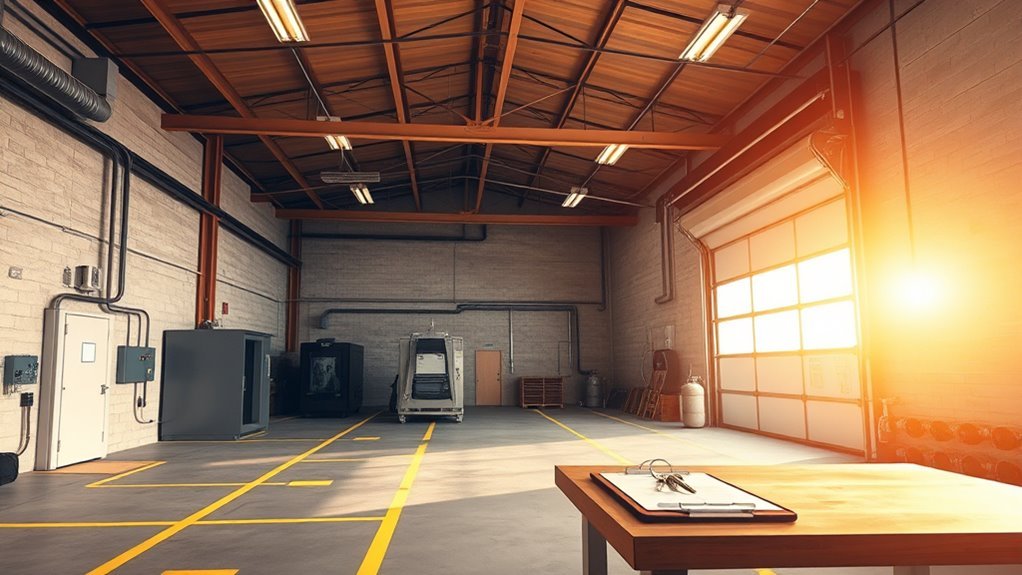
Plan on rent eating a predictable chunk of your startup budget — typically $1,000 to $5,000 per month depending on location and size — and factor in that you’ll likely need 1,000–3,000 sq ft to accommodate machines, storage, and safe workflow.
Choose a space in an industrial zone if you can, but expect higher rent; verify zoning rules early so you don’t commit to a site that won’t allow welding.
Design your facility layout to minimize material handling and separate hot work, storage, and administrative areas to reduce risk and improve throughput.
Budget electricity as a major recurring cost — several hundred dollars monthly depending on equipment load — and add $200–$500 for water, heating, and waste disposal.
Implement basic utility management: metered circuits for heavy welders, LED lighting, and scheduled HVAC to cut bills.
Factor in hookup fees or upgrades if the panel capacity is insufficient; those one-time upgrades can materially affect your startup capital needs.
Licensing, Certification, and Insurance Costs

You’ll need to budget for certifications, permits, and insurance as fixed overheads that directly affect your pricing.
AWS and specialized welding certifications typically run $300–$2,000 each, business licenses and zoning permits $50–$500, and general liability about $400–$1,200 annually (workers’ comp varies by payroll).
Don’t forget renewal fees of roughly $100–$300 every few years when projecting ongoing costs.
Welding Certifications Cost
Because certifications, licensing, and insurance directly affect both your credibility and your bottom line, you should budget them carefully when starting a welding shop.
A practical welding certifications overview shows costs typically run $300–$2,500 depending on type and provider. AWS exams usually cost $500–$1,000. State licensing can add several hundred dollars more.
Insurance (general liability, workers’ comp) often adds $800–$2,000 yearly, so include it in startup math.
- Compare certification types (AWS vs. trade schools) and fees.
- Factor state licensing fees and any mandatory training costs.
- Plan for the certification renewal process: recurring testing or refresher courses.
- Allocate annual insurance premiums into operating budget projections.
Budget tightly — these items materially affect your initial and ongoing costs.
Insurance and Permits
While getting your welding shop up and running, don’t underestimate the upfront and recurring costs of licenses, certifications, and insurance — they typically add several hundred to a few thousand dollars to your startup budget.
You’ll need local business licenses and permit requirements can run $50 to several hundred dollars depending on jurisdiction.
Factor AWS welding certifications at $300–$1,000 per qualification.
For insurance types, budget general liability at $500–$2,000 yearly and workers’ compensation if you hire — roughly $1.00–$2.50 per $100 payroll.
Don’t forget compliance: safety inspections and equipment certifications can push annual costs over $1,000.
Add these predictable line items into your cash flow projections so you avoid surprises.
Staffing, Payroll, and Ongoing Operational Expenses

Start by budgeting for people and monthly shop overhead, since labor and recurring costs will make up the largest slice of your operating budget.
You’ll need tight payroll management to control wages ($20–$40/hr for experienced welders), plus benefits and payroll taxes. Factor workers’ compensation (1–5% of payroll) and plan for employee retention costs like training and modest incentives to reduce turnover.
- Labor: calculate headcount, hours, and wage bands; include overtime scenarios.
- Rent & utilities: budget $1,000–$5,000/month for space and $200–$500 for utilities.
- Consumables: set a monthly materials reserve of $500–$1,500 for wire, rods, gas.
- Maintenance & insurance: allocate $100–$1,000/year for equipment upkeep, plus insurance premiums beyond workers’ comp.
Keep monthly and annual forecasts separate, review cash flow monthly, and build a three-month operating reserve so payroll and suppliers are covered during slow periods.
Marketing, Website, and Business Development Budget
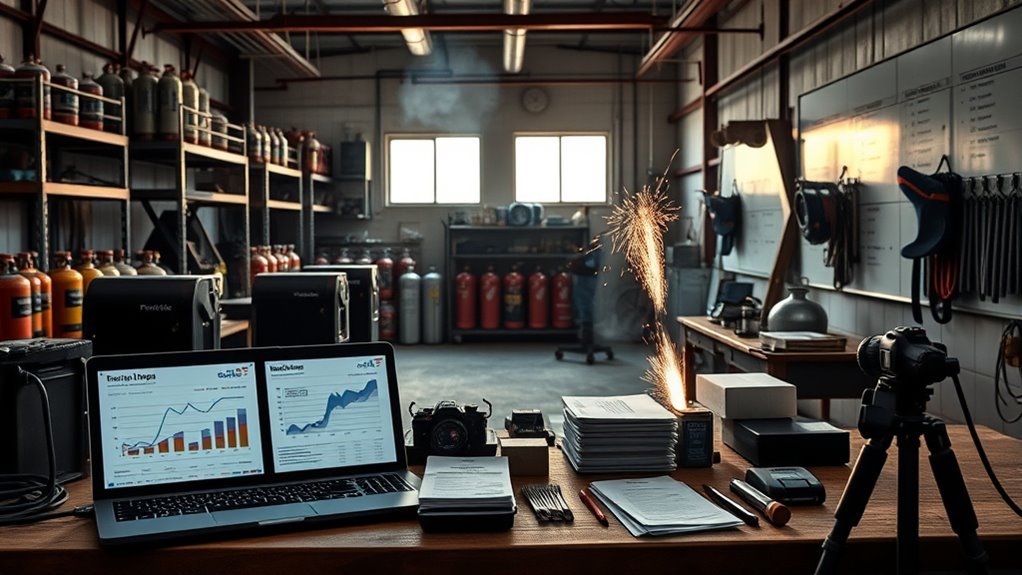
You’ll want a clear budget for branding, website setup, and local advertising so costs don’t surprise you.
Expect to spend $100–$800 on a logo and basic brand materials, $500–$3,000 to get a professional site live (domain, hosting, design), and $1,000–$5,000 annually for overall marketing with $100/month minimum for social ads and $50–$200 for business cards.
Prioritize line items—brand identity, site build, and targeted local ads—so you can adjust spend as leads and ROI become clear.
Branding and Logo Design
Because first impressions matter, investing in clear branding and a professional logo lets you command higher rates and win more clients.
So plan to budget $500–$5,000 for design and another $2,000–$10,000 for a functional website (hosting and maintenance included).
You should treat branding strategies and logo importance as core startup expenses—allocate 10–15% of your startup budget to marketing to guarantee consistent materials, social media, and client outreach.
Cheap templates or crowdsourced platforms save money but may cost recognition; consider a mid-range designer for balance.
Focus on usable deliverables: vector logo, color palette, fonts, and application guides so every touchpoint looks professional and repeatable.
- Vector logo and variations
- Color palette and typography
- Business card and social mockups
- Brand usage guidelines
Website Setup Costs
With your brand assets in hand, allocate a clear budget for getting the shop online: a basic website will usually run $500–$5,000 depending on whether you DIY or hire a pro, plus $10–$50/month for hosting and about $10–$20/year for a domain.
Decide on website design priorities—service pages, portfolio, contact form—and pick templates or a designer accordingly. Compare hosting options (shared, VPS, managed WordPress) by uptime, backups, and support to fit your traffic and budget.
Plan for SEO investment ($100–$500/month) to drive local searches and track conversions. Factor in ongoing maintenance and occasional content updates.
Keep initial spend lean, then scale website design and hosting options as revenue and leads grow.
Local Advertising Budget
When planning your local advertising budget, set a clear annual range—typically $500–$5,000 for basic local tactics—and layer in website and business-development costs so nothing’s overlooked.
You’ll allocate funds across local marketing, advertising strategies, website setup ($1,000–$3,000 plus hosting), and SEO/Google Business Profile setup ($300–$1,000). Aim to reserve 10–15% of projected revenue for ongoing marketing to sustain customer acquisition.
- Local print/flyers/sponsorships: $500–$5,000 yearly.
- Website creation and hosting: $1,000–$3,000 initial, then annual maintenance.
- Local SEO and Google Business Profile: $300–$1,000 setup.
- Business development (events, associations): $200–$1,000 per year.
Track ROI and reallocate to the most effective advertising strategies.
Pricing Strategy and How to Recover Startup Costs
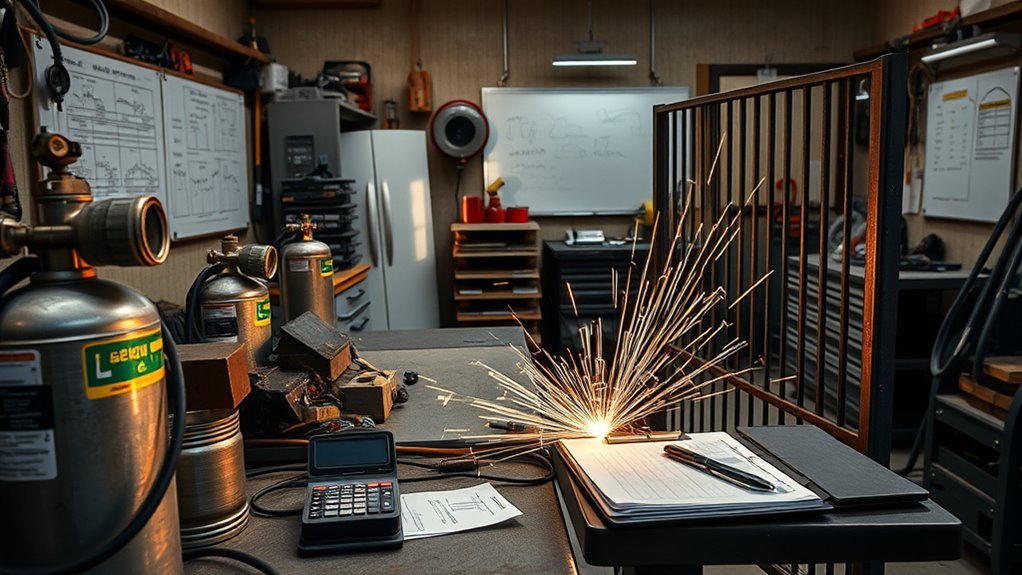
Although startup costs for a welding shop can easily fall between $15,000 and $50,000 or more, you can recover that investment faster by pricing deliberately—balancing labor, materials, and overhead while staying competitive in your local market.
Break costs into direct materials, productive labor, and fixed overhead, then set target margins that cover unforeseen downtime and equipment wear. Use mixed pricing models: hourly rates for variable, complex jobs and flat rates for repeatable, predictable work; that combination simplifies quoting and speeds recovery.
Always give written estimates that list labor hours, material markup, and fees—transparency builds customer trust and reduces disputes. Track job profitability weekly, cut low-margin offerings, and optimize workflow to raise effective hourly revenue.
Price promotions carefully: don’t erode long-term margins just to win work. Finally, invest a portion of early profits into local advertising and referral incentives to boost volume; steady, profitable volume is the fastest path to recouping your startup outlay.
Ways to Finance and Reduce Your Startup Investment
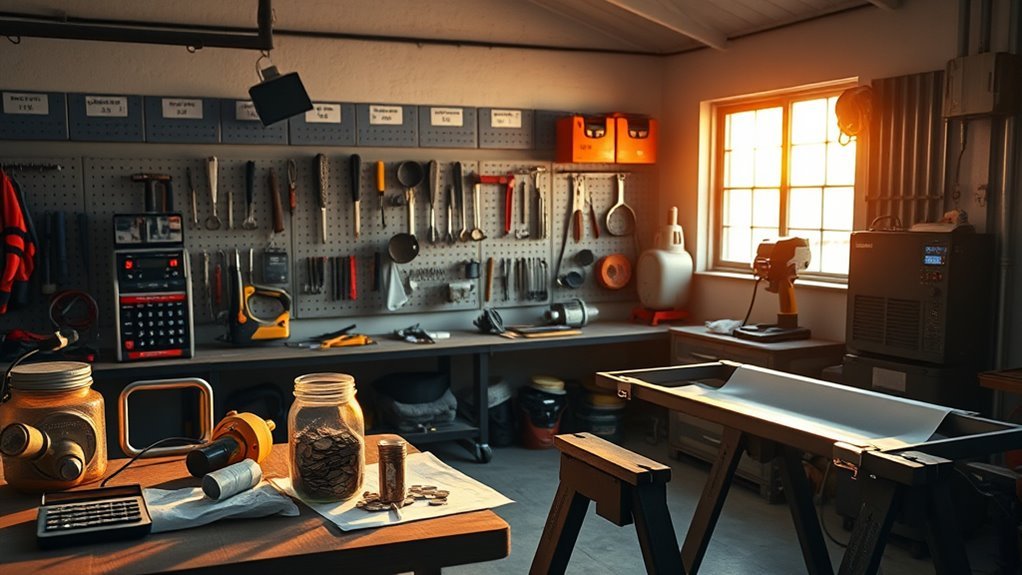
You’ve priced jobs and started tracking profitability — now look at how to fund and shrink that upfront bill. Break costs into fixed, ongoing, and one-time expenses so you know exactly what to finance and what to cut.
Apply for government grants and small-business loans to cover $15,000–$50,000+ startup needs; grants reduce debt, loans bridge gaps. Form an LLC for liability protection and potential tax advantages that affect cash flow.
Apply for grants and small-business loans ($15K–$50K+) and form an LLC for liability protection and cash-flow benefits.
- Lease or equipment rental to access welders and torches without large purchases; compare daily vs. monthly rates.
- Buy used machines to slash capital outlay, but factor in potential repair costs and lack of warranty into your budget.
- Partner with another fabricator to share shop space and utilities, splitting fixed costs and reducing break-even.
- Prioritize one-time buys vs. deferred purchases; finance critical items now and lease or rent nonessential equipment.
Frequently Asked Questions
How Do I Handle Hazardous Waste Disposal From Welding Operations?
You’ll segregate hazardous materials, label containers, and follow local waste management rules; you’ll contract licensed haulers, keep records, train staff, and budget for disposal fees, permits, and spill response supplies to control costs.
What Are Common Zoning Restrictions for Welding Shops?
You’ll face zoning laws restricting welding shops to industrial zones or mixed-use areas, limiting noise, emissions, and business hours; you’ll need permits, setback and parking compliance, and sometimes conditional use approvals—budget for permit and mitigation costs.
How Do I Secure Work Contracts From Construction Firms?
Hit the ground running: build strong client relationships, target firms, and sharpen bidding strategies with clear scopes, competitive cost breakdowns, subcontractor vetting, certifications, and timely follow-ups — you’ll win contracts by proving value and managing risk.
What Software Is Best for Job Estimating and Tracking?
You should pick job management software that combines cost estimation and scheduling, like Buildertrend, Procore, or Knowify; they track bids, labor, materials, change orders, and reporting so you’ll control expenses and improve project profitability.
How Should I Set up Apprentice Training and Safety Programs?
Practical programs provide progressive plans: you’ll pair apprentice benefits with paid practical practice, structured safety SOPs, monthly mentoring, clear competency checklists, scoped training resources, documented drills, regular audits, and budgeted certification costs to control expenses.
Conclusion
You’re looking at roughly $15,000–$50,000 to get rolling, so plan tightly: prioritize a reliable MIG welder, safety gear, basic hand tools, and a modest rented bay before luxuries like a CNC plasma. Budget licenses, insurance, and a small marketing fund, and set wage and utility contingencies. Use a mix of savings, a small loan, or equipment leasing to stretch capital. Like a pocket watch in a smartphone age, stay practical, track every dollar, and price jobs to recover costs fast.

